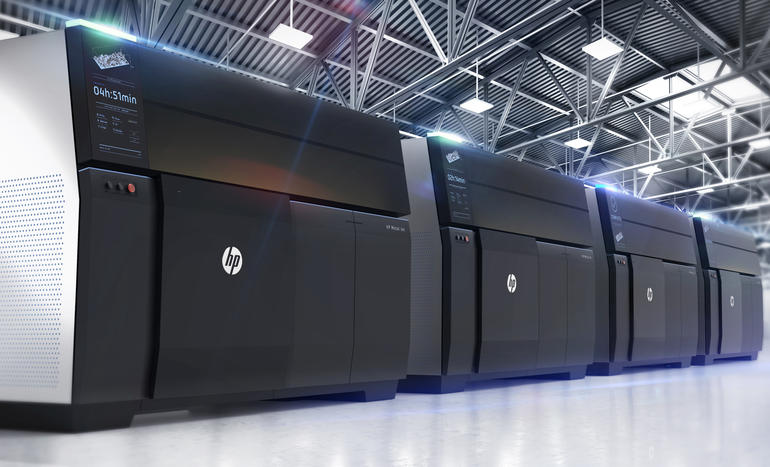
HP launched its HP Metal Jet 3D printing technology that’s designed to deliver mechanically functional parts faster than current systems with the aim of revamping factory production for auto, industrial and healthcare companies.
The company unveiled plans for its HP Metal Jet at the International Manufacturing Technology Show.
In addition, HP outlined partnerships with GKN Powder Metallurgy and Parmatech to create Metal Jet parts for Johnson & Johnson, Volkswagen and Wilo. HP will also add a production service to deliver final parts beginning in 2019. HP will stand up plants with its partners so engineers can design and start to scale parts.
The initial metal focus for HP will revolve around stainless steel because it is targeting mass production. Metals like titanium are more specialized. Iron and steel are areas that apply more to mass production. HP’s move into metals was among the company’s goals for 2018.

As demand forms, HP will move into other metals too. HP’s roadmap for Metal Jet 3D printing systems features parts produced today with partners, the production service in 2019, select availability in 2020 and a broad rollout in 2021.
Special Feature
3D Printing: Building the Future
When you look at the industries that 3D printing is destined to disrupt in the future, the list is long and distinguished. Here is our take on the state of 3D printing, the ways companies are using it today, and how it’s going to revolutionize the future of business.
HP’s 3D printing unit competes with 3D Systems and Stratasys. Both rivals have built up vertical efforts and have focused on large-scale production. Stratasys is looking for a new CEO and 3D Systems is run by HP veteran Vyomesh Joshi, who used to run HP’s imaging and printing group. 3D Systems CEO Joshi on additive manufacturing, materials innovation and the state of 3D printing
In the first half of 2019, customers can upload 3D design files and get industrial grade parts in large quantities from the Metal Jet Production Service. Commercial Metal Jet systems will be available in 2020 starting for less than $399,000. Preorders are available today.
Dr. Tim Weber, global head of HP’s metals 3D printing business, said the company is focused on mass production not specialized efforts. HP’s Weber said he expects HP to take share from incumbents such as 3D Systems and Stratasys. In February, Stratasys said it was developing a new metal platform for short-run manufacturing. 3D Systems also has a portfolio of metal systems.
Weber said HP has been investigating metals along with other areas for years. “3D printing pales in comparison compared to manufacturing. We’ve been setting our sights on prototyping to production to mass production,” said Weber.
HP and 3D printing: HP gets new 3D printing leader, aims to scale business | HP launches 3D printing center in China | HP’s PC and printing units buy it time for 3D printing growth | HP teams with Jabil, Forecast 3D to expand Multi Jet Fusion presence | HP aims to use its Multi Jet Fusion additive manufacturing technology in its supply chain | HP launches 3D Multi Jet printers that aim to deliver fully functional, color parts with systems in $50,000 range
While HP has been focused on plastics, the move to metals is designed to broaden additive manufacturing into more markets. HP’s 3D printing strategy revolves around building investigative teams for research, disrupting a market, scaling and have solid economics.
Moore’s Law for additive manufacturing
HP’s 3D printing strategy rhymes with what it has done in inkjets. Every 18 months, HP’s printing systems for ink has taken a leap, said Weber, who noted HP has its own Moore’s Law effect for printing.
The company is hoping the same effect unfolds for Metal Jet. Weber said HP Metal Jet will be able to deliver production parts for customers and the quality will improve over time. “Our parts are being measured as isotropic to meet ASTM standards for stainless steel,” he said.
Weber’s examples of parts included an overhead cam that could be produced more cheaply with short run manufacturing. Those costs should fall overtime as breakeven points fall for customers as the technology evolves. “This can enable our customers to go after new markets because they won’t need the cost associated with upfront tooling,” said Weber.
To make this Moore’s Law analogy fly, Weber said that the services bureaus will be critical. He said HP wanted to get going early, stand up processes and iterate until Metal Jet is broadly available. “We are standing up the Metal Jet production service and then it’s all about the applications and enabling the economics,” said Weber.
More: Back to school: We test inexpensive 3D printers for students of all ages | Additive manufacturing firms gear up for 3D-printed parts race in aviation | 3D-printed bones? New ‘hyperelastic’ material could let doctors print implants on demand | Stratasys demos 3D printing, additive manufacturing systems that take cues from data center
Related: Exclusive: Ultimaker on 3D printing today and in the future | 3D Systems outlines additive manufacturing strategy, aims for turnaround | Stratasys launches BioMimics, aims to bolster medical training, cut cadaver costs | Stratasys demos 3D printing, additive manufacturing systems that take cues from data center
TechRepublic: How Toyota uses 3D printing for full scale vehicle mockups | IT pro’s guide to 3D printing technologies (free PDF) | 3D printing: The smart person’s guide

